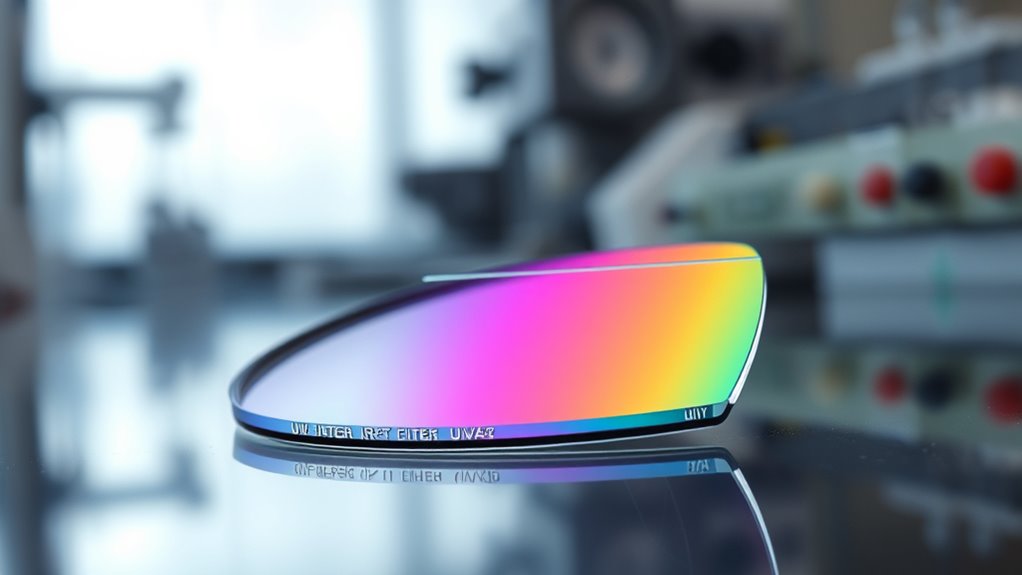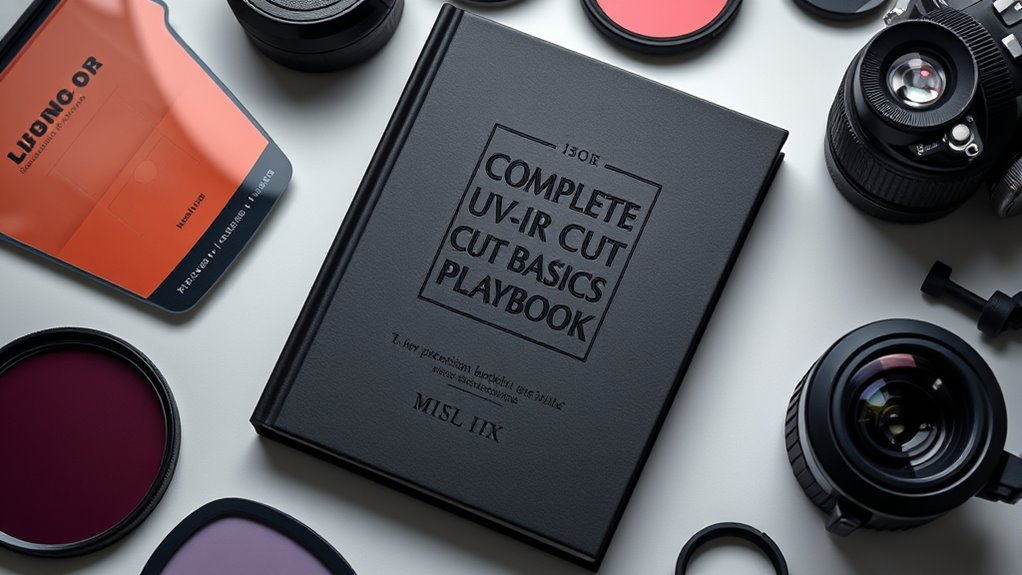The UV IR Cut Basics Playbook helps you understand how filters block harmful ultraviolet and infrared rays, protecting your camera sensor and ensuring accurate color capture. These filters are typically made from glass or plastic, coated to selectively absorb unwanted wavelengths and prevent haze or distortion in your photos. Using high-quality, multi-coated filters enhances durability and preserves image clarity. Continue exploring to discover how to choose the right filters and optimize your photography setup effectively.
Key Takeaways
- UV IR cut filters block harmful ultraviolet and infrared rays to improve image clarity and prevent sensor damage.
- Made from coated glass or plastics, these filters selectively absorb or reflect specific wavelengths.
- Proper filtering reduces haze, distortion, and color inaccuracies caused by UV and IR light.
- High-quality, multi-coated filters enhance durability, scratch resistance, and overall image quality.
- Selecting the correct filter size and coating ensures compatibility and optimal protection for your camera gear.
Understanding UV and IR Filtering Techniques

Have you ever wondered how camera lenses and filters block harmful ultraviolet (UV) and infrared (IR) rays? It’s all about effective filtering techniques that prevent these rays from reaching your camera’s sensor. Without proper filtering, UV and IR light can cause color distortions, reduce image clarity, and even damage your equipment over time. That’s where specialized filters come into play, ensuring your photos stay true to life and your gear remains protected. Filtering techniques involve the strategic use of optical filters designed to absorb or reflect unwanted UV and IR radiation. These filters are typically made from glass or optical plastics coated with thin layers of materials that selectively block specific wavelengths. By attaching a UV/IR cut filter to your camera lens, you effectively create a barrier that filters out these harmful rays before they reach your sensor. This not only improves image quality by maintaining accurate color reproduction but also reduces haze and distortion caused by UV light in outdoor photography. Additionally, filter coatings can enhance durability and resistance to scratches, ensuring long-lasting performance. Sensor protection is a vital benefit of using UV IR cut filters. Over time, exposure to UV and IR rays can cause long-term damage to your camera’s sensor, degrading its performance and lifespan. Installing these filters acts as a shield, absorbing the majority of the unwanted radiation. This minimizes the risk of sensor deterioration and ensures your camera continues to produce sharp, vibrant images. In addition to protecting your gear, filtering techniques help in maintaining the integrity of your images, especially in bright or high-altitude environments where UV radiation is more intense. Choosing the right UV IR cut filter depends on your specific photography needs. For general use, a high-quality multi-coated filter can reduce glare and reflections, while also offering durability against scratches and dirt. Some filters are designed to be neutral, meaning they won’t affect the color balance of your images, while others might have slight tints to enhance certain conditions. Proper filtering techniques require you to consider factors like filter thickness, coating quality, and compatibility with your lens to get ideal results.
Frequently Asked Questions
How Do UV and IR Filters Affect Overall Image Quality?
UV and IR filters improve your image quality by reducing unwanted ultraviolet and infrared light, which can cause haze and color distortions. This results in better image clarity and more accurate colors. By blocking these wavelengths, you prevent color casts and enhance sharpness. Using these filters, you guarantee your photos maintain true-to-life colors and crisp details, making your images clearer and more vibrant.
Can Uv/Ir Filters Be Used With Smartphone Cameras?
Yes, you can use UV/IR filters with smartphone cameras. They’re generally mobile-compatible and easy to attach, making them a great addition to your gear. Just make certain the filter’s size fits your phone’s lens. Look for durable filters that withstand everyday use, including scratches and impacts. This way, you’ll protect your camera lens and improve image quality without sacrificing ease of use or filter durability.
What Are the Differences Between Glass and Plastic Filters?
Think of glass filters as the sturdy fortress guarding your camera, while plastic filters are the lightweight scout. Glass offers superior clarity, better UV/IR cutoff, and resists scratches longer, making it more durable. Plastic filters are cheaper and lighter but can scratch easily and may degrade over time. When choosing, consider your environment—if durability matters most, glass stands strong; for portability, plastic might be enough.
How Do Weather Conditions Influence UV and IR Filtering?
Weather conditions substantially impact UV and IR filtering by affecting atmospheric absorption. On cloudy or foggy days, these conditions increase atmospheric absorption, reducing UV and IR radiation reaching your filters. Strong sunlight, clear skies, or high humidity can intensify filtering needs, as more radiation passes through. You should adjust your filter settings or choose specialized filters to account for weather impact, ensuring ideal protection and image quality in varying conditions.
Are There Any Health or Safety Concerns With Uv/Ir Filters?
You should be aware that some UV/IR filters can cause skin sensitivity or contain toxic materials. For example, certain glass filters may emit fumes if heated, posing inhalation risks. Typically, these concerns are minimal when filters are used properly, but always verify the filter’s material is non-toxic and handle it with care. If you have sensitive skin, consider filters made from hypoallergenic materials to avoid irritation.
Conclusion
Now that you’ve learned the fundamentals of UV and IR filtering, you’re equipped to protect your equipment and capture true-to-life images. Think of filters as the sunglasses for your camera—blocking out unwanted glare and haze. Just like sunglasses improve your view on a bright day, these filters enhance your photos by filtering out harmful rays. With this knowledge, you’re ready to see the world through a clearer, more accurate lens—literally.









